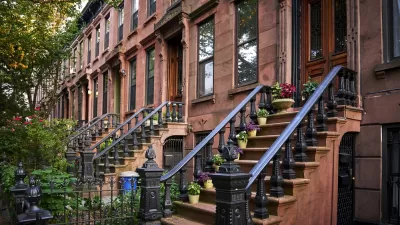Fannie Mae and Freddie Mac will deliver $10.2 billion in dividends to the U.S. Treasury next month, but Congress could soon "wind down" the companies by approving the significant Johnson-Crapo bill.
The next few weeks and months will determine the future (or lack thereof) for government-backed mortgage finance companies Fannie Mae and Freddie Mac.
First comes news that the two companies recently sent their profits to the U.S. Treasury under terms of their bailout deal from 2008.
Maggie McGrath reports on the first quarter profits of the companies: "Fannie Mae posted $5.3 billion in net income for the first quarter of 2014 and comprehensive income of $5.7 billion, the company’s ninth consecutive quarterly profit though a notable downturn from the $58.7 billion reported as net income in the year-ago period. The difference is largely attributable to a one-time accounting move that allowed Fannie Mae to apply losses from delinquent mortgages."
"Freddie Mac, meanwhile, reported $4 billion in net income, down $4.6 billion from the prior-year period thanks to derivative losses and lower legal settlement proceeds. The company’s comprehensive income came in at $4.5 billion, and like Fannie Mae, that figure is heading straight into the hands of Uncle Sam. After this dividend is paid in June, Freddie Mac will have repaid the Treasury a total of $86.3 billion, a sum that’s nearly $15 billion higher than the $71.3 billion it borrowed."
The earnings are a temporary blip, however, and not a long-term trend toward profitability. An article by Nick Timiraos and Eliot Brown quotes Jim Vogel, a debt-market analyst at FTN Financial, to describe Fannie and Freddie's long-term prospects: "Bottom line, Fannie and Freddie are not inherently profitable operations in any conventional sense beyond the next couple of years." Given that uncertainty, Congress is expected to vote soon on legislation—the so-called Johnson-Crapo bill—that could break the mortgage giants up.
Bendix Anderson writes of the possible implications of the legislation on multi-family lending. "The Johnson-Crapo bill proposes replacing Fannie Mae and Freddie Mac...with a new and independent federal agency called the Federal Mortgage Insurance Corp. (FMIC)," explains Anderson. "The final impact for multifamily borrowers might be slightly higher interest rates for multifamily loans provided under the new FMIC loans that would replace the Fannie Mae and Freddie Mac program loans."
In a separate report, Alexander MacLennan discusses the Johnson-Crapo legislation as well as a recent stress test that found the companies to be at risk of $190 billion in losses in the event of another downturn.
Finally, an editorial by Harry Alford calls for Congress to reform Fannie and Freddie rather than killing them. According to Alford, "with Johnson-Crapo, Congress is threatening to jeopardize that stability and undo years of resilience from American taxpayers."
FULL STORY: Fannie Mae And Freddie Mac Sending Treasury $10.2 Billion After Posting First Quarter Profits

Alabama: Trump Terminates Settlements for Black Communities Harmed By Raw Sewage
Trump deemed the landmark civil rights agreement “illegal DEI and environmental justice policy.”

Planetizen Federal Action Tracker
A weekly monitor of how Trump’s orders and actions are impacting planners and planning in America.

The 120 Year Old Tiny Home Villages That Sheltered San Francisco’s Earthquake Refugees
More than a century ago, San Francisco mobilized to house thousands of residents displaced by the 1906 earthquake. Could their strategy offer a model for the present?

Ken Jennings Launches Transit Web Series
The Jeopardy champ wants you to ride public transit.

BLM To Rescind Public Lands Rule
The change will downgrade conservation, once again putting federal land at risk for mining and other extractive uses.

Indy Neighborhood Group Builds Temporary Multi-Use Path
Community members, aided in part by funding from the city, repurposed a vehicle lane to create a protected bike and pedestrian path for the summer season.
Urban Design for Planners 1: Software Tools
This six-course series explores essential urban design concepts using open source software and equips planners with the tools they need to participate fully in the urban design process.
Planning for Universal Design
Learn the tools for implementing Universal Design in planning regulations.
Clanton & Associates, Inc.
Jessamine County Fiscal Court
Institute for Housing and Urban Development Studies (IHS)
City of Grandview
Harvard GSD Executive Education
Toledo-Lucas County Plan Commissions
Salt Lake City
NYU Wagner Graduate School of Public Service



























